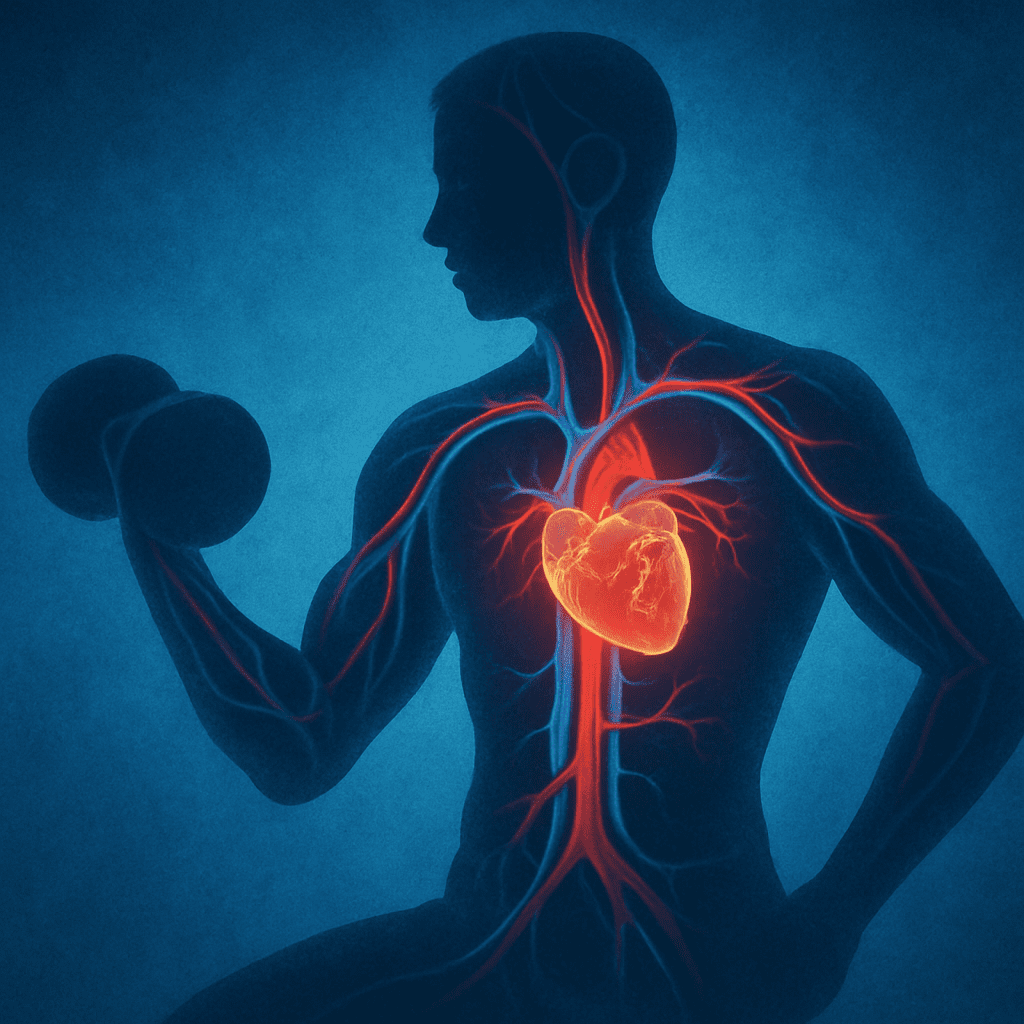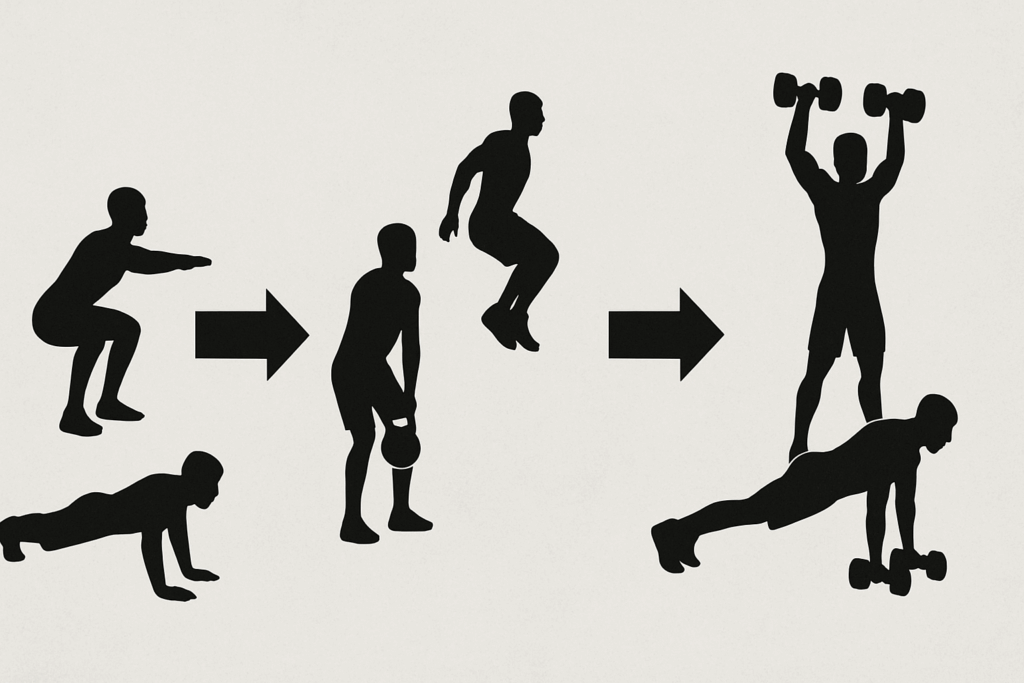In today’s evolving landscape of fitness and wellness, cardiovascular circuit training exercises have emerged as one of the most efficient, research-supported ways to elevate endurance, support heart health, and accelerate fat loss. Unlike traditional workouts that isolate aerobic or strength components, this approach integrates both into a seamless, high-intensity format. The result is a highly adaptable workout model that not only builds physical stamina but also strengthens the cardiovascular system in profound ways. As more individuals seek time-efficient, full-body workouts, the popularity of cardio circuit workouts continues to grow among athletes, fitness professionals, and beginners alike.
You may also like: Smart Nutrition Choices for a Healthier Lifestyle: What to Know About Whole Grain Rice and Whole Wheat Rice

Understanding the Fundamentals of Cardiovascular Circuit Training
Cardiovascular circuit training combines structured aerobic intervals with functional strength movements performed in rapid succession. The goal is to keep the heart rate elevated throughout the workout while minimizing rest between exercises. This constant challenge to the cardiovascular and muscular systems simultaneously stimulates improvements in endurance and strength. Each aerobic exercise circuit is designed to target large muscle groups while encouraging sustained movement, often in the form of short, intense bursts that promote both aerobic and anaerobic conditioning.
Unlike traditional steady-state cardio, which may involve 30–60 minutes of consistent running or cycling, cardio circuit workouts alternate between different types of movement, such as squats, jumping jacks, push-ups, and lunges. This variety ensures the entire body is engaged, which increases the overall caloric burn and reduces the risk of overuse injuries. Additionally, this training style can be scaled to suit any fitness level by adjusting work intervals, modifying exercises, or adding resistance equipment.

How Cardio Circuit Workouts Boost Fat Loss and Metabolic Function
A central appeal of cardiovascular circuit training is its potent fat-burning capability. High-intensity sessions elevate heart rate and promote the “afterburn effect”—scientifically referred to as excess post-exercise oxygen consumption (EPOC). This phenomenon causes the body to consume more oxygen and burn more calories even after the workout is complete. Compared to lower-intensity aerobic training, a well-structured cardio circuit not only burns more calories during the session but continues working long afterward, making it especially beneficial for weight loss and body composition goals.
Cardio circuit training workouts also preserve lean muscle mass while promoting fat oxidation, which is vital for sustainable weight management. When combined with a nutrient-dense diet and adequate recovery, this training style helps reduce visceral fat, the type most closely linked to chronic health risks. It’s not just about the scale—regular aerobic exercise circuits improve metabolic markers such as blood glucose regulation, insulin sensitivity, and cholesterol levels, supporting overall metabolic resilience.

Endurance Enhancement Through Integrated Cardio and Strength Protocols
Improving endurance is a cornerstone of both athletic training and long-term health, and cardiovascular circuit training is uniquely suited for this purpose. These workouts consistently challenge the heart and lungs by encouraging sustained, repetitive engagement of large muscle groups. This improves VO₂ max—the body’s capacity to utilize oxygen efficiently—which is a key determinant of cardiovascular fitness and stamina.
Because cardio circuits alternate between different movements, they also avoid the physical and mental fatigue associated with repetitive activities like running or cycling. For example, combining jumping rope with kettlebell swings and mountain climbers not only stimulates different muscle fibers but also maintains high cardiovascular output. Over time, this variety leads to a more efficient heart, stronger lungs, and a circulatory system that can deliver oxygen to working muscles with greater precision.
For athletes, the benefit is enhanced sport-specific performance, whether that means running longer distances, sustaining faster paces, or recovering more quickly between efforts. For everyday exercisers, it means walking upstairs without becoming breathless, playing with children with more energy, or tackling long workdays with sustained focus and vigor.

The Profound Impact on Cardiovascular Health
Perhaps the most significant benefit of cardiovascular circuit training exercises lies in their effect on heart health. Consistent participation in cardio circuit workouts leads to reductions in resting heart rate, systolic and diastolic blood pressure, and LDL cholesterol levels. At the same time, they help elevate HDL cholesterol—the “good” kind—supporting a healthier lipid profile. These changes significantly reduce the risk of atherosclerosis, stroke, and coronary heart disease over time.
By frequently pushing the heart to work harder during aerobic exercise circuits and allowing it to recover during brief rest periods, the heart muscle becomes more efficient. This improved stroke volume—the amount of blood the heart pumps with each beat—means the heart doesn’t have to work as hard during rest or everyday tasks. For individuals with risk factors such as hypertension or a sedentary lifestyle, regular cardiovascular circuit sessions serve as a powerful intervention.
Research consistently supports these outcomes. Studies published in journals such as Circulation and the American Journal of Cardiology highlight that even moderate-intensity cardiovascular circuits practiced three to five times per week can lead to measurable improvements in endothelial function and heart rate variability—both strong predictors of long-term cardiac health.
Time Efficiency and Functional Benefits for Modern Lifestyles
A major barrier to consistent exercise is lack of time, but cardiovascular circuit training removes that excuse. These workouts typically last between 20 and 40 minutes, delivering both cardiovascular and strength benefits in a fraction of the time it takes to complete separate sessions. Because they require minimal equipment and can be done almost anywhere, cardio circuit workouts are particularly useful for busy professionals, students, and parents.
In addition to saving time, the movements used in cardio circuits are typically functional—meaning they mirror real-life actions. Exercises like squats, lunges, and push-ups train the body in movement patterns that support daily activities. This not only enhances mobility and balance but also reduces the risk of falls and injuries, especially in older adults. Functional strength translates directly to quality of life, allowing individuals to maintain independence as they age.

Mental Health and Cognitive Benefits of Cardiovascular Circuits
While the physical benefits of aerobic exercise circuits are well-established, their impact on mental and emotional well-being should not be overlooked. Engaging in regular cardio circuit training workouts can elevate mood, reduce symptoms of anxiety and depression, and improve cognitive performance. This is largely due to the release of endorphins, dopamine, and serotonin during high-intensity physical activity.
Furthermore, the rhythm and structure of a cardiovascular circuit can promote mindfulness. Focusing on form, breathing, and timing helps anchor the mind in the present, creating a meditative state that supports mental clarity and emotional regulation. These effects are especially valuable in today’s fast-paced world, where chronic stress and digital overload are commonplace.
Emerging research also suggests that consistent aerobic activity—including cardiovascular circuits—enhances neuroplasticity, the brain’s ability to adapt and form new neural connections. This may offer protective effects against age-related cognitive decline and neurodegenerative conditions like Alzheimer’s disease, making cardio circuits a true investment in long-term brain health.

Optimizing Performance Through Customization and Progression
One of the defining strengths of cardiovascular circuit training exercises is their versatility. Because they can be tailored to accommodate fitness level, physical limitations, or training goals, they are accessible to nearly everyone. Beginners might begin with low-impact movements and longer rest intervals, while advanced athletes can perform explosive, high-intensity circuits with added resistance and shorter recovery.
Progression is key to avoiding plateaus. This can be achieved by increasing the number of rounds, decreasing rest periods, incorporating heavier weights, or introducing more complex movements. For example, replacing a basic squat with a jump squat or integrating compound exercises like a thruster (squat to overhead press) can intensify the challenge while promoting continued adaptation.
Additionally, sports-specific cardio circuits can be designed to mimic the demands of particular disciplines. A soccer player might include lateral shuffles and sprints, while a swimmer could benefit from medicine ball slams and plank holds. These sport-adapted circuits improve both cardiovascular conditioning and neuromuscular efficiency relevant to athletic performance.
Safety, Recovery, and Sustainable Practice
As with any training method, safety is paramount. Cardiovascular circuit training should be approached thoughtfully, especially by those with preexisting health conditions or injuries. A thorough warm-up, including dynamic stretching and mobility drills, prepares the joints and muscles for high-intensity activity. Post-workout cooldowns, combined with static stretching and hydration, aid recovery and minimize soreness.
Recovery should also be built into weekly routines. Though cardiovascular circuits are effective, performing them daily without rest can lead to overtraining and diminish returns. A balanced schedule that includes low-intensity recovery days, strength-focused sessions, and restorative activities such as yoga or walking will maximize benefits while reducing injury risk.
Listening to the body is critical. Signs of overtraining—such as persistent fatigue, irritability, sleep disturbances, or declining performance—should be taken seriously. Adjusting intensity and incorporating rest as needed ensures long-term sustainability and continued progress.
The Widespread Accessibility of Cardio Circuit Workouts
One of the most empowering aspects of cardiovascular circuit training is its accessibility. These workouts can be performed in gyms, at home, in parks, or even in hotel rooms. With minimal equipment—sometimes just bodyweight—individuals can build effective routines that require no expensive gear or memberships. Apps, online videos, and community-based programs make it easier than ever to get started and stay consistent.
Group fitness settings also provide a supportive environment that boosts motivation and accountability. Whether in person or virtual, exercising alongside others can create a sense of camaraderie and shared purpose. This social dimension enhances enjoyment and increases the likelihood of long-term adherence.
From young adults preparing for athletic events to older adults maintaining vitality, the cardiovascular circuit model offers something for everyone. Its inherent adaptability and practicality make it a valuable addition to any health-focused lifestyle.
Frequently Asked Questions: Cardiovascular Circuit Training Exercises
1. How does a cardio circuit workout influence long-term cardiovascular resilience?
Beyond the immediate effects on heart rate and calorie burn, cardio circuit workouts stimulate structural changes in the heart and vascular system that enhance long-term resilience. Over time, consistent exposure to aerobic exercise circuits increases the elasticity of blood vessels and supports better heart rate variability, which is a key marker of cardiac adaptability. This means the body becomes more efficient at responding to both physical and emotional stress. Additionally, cardiovascular circuit training exercises can reduce inflammation markers such as C-reactive protein, which is linked to heart disease risk. These adaptations contribute to a more robust cardiovascular circuit system that withstands aging and daily stressors more effectively.
2. Can cardiovascular circuit training workouts improve sleep quality?
Surprisingly, yes. The physiological demands of cardiovascular circuit training stimulate the parasympathetic nervous system post-exercise, leading to a more restful state conducive to deep sleep. Regular aerobic exercise circuits help regulate circadian rhythms and reduce cortisol levels, particularly when workouts are performed earlier in the day. The mental focus required in a well-executed cardio circuit workout also promotes cognitive fatigue, which can help ease insomnia. Anecdotal evidence from personal trainers and sleep researchers alike supports the role of cardio circuits in promoting restorative sleep, especially in high-stress individuals.
3. What role do cardiovascular circuit training exercises play in injury prevention for athletes?
Unlike sport-specific drills that can sometimes create muscular imbalances, cardiovascular circuit training workouts tend to engage opposing muscle groups equally. A well-designed cardio circuit includes movements that promote joint stability, core strength, and muscular symmetry, all of which are essential for reducing injury risk. Additionally, because many aerobic exercise circuits incorporate dynamic stretches and mobility work as part of their warm-up or cool-down, they further enhance injury prevention. This well-rounded movement pattern fosters better body awareness and neuromuscular control, which translates to fewer sprains, strains, and repetitive stress injuries. For athletes recovering from prior injuries, a cardio circuit can also serve as a safe reconditioning method.
4. How can someone personalize their aerobic exercise circuit based on their fitness goals?
Personalization starts with identifying primary goals such as fat loss, endurance, muscle definition, or overall health. A person aiming for fat loss might benefit from shorter rest periods and high-intensity intervals in their cardio circuit workout, while someone focused on endurance could use longer circuits with sustained aerobic effort. Resistance tools like kettlebells or resistance bands can be added to cardiovascular circuit training exercises to increase strength components. Beginners may opt for low-impact moves to build confidence and avoid strain, whereas experienced athletes can incorporate sport-specific drills. The flexibility of the cardiovascular circuit model makes it an ideal framework for tailoring programs to evolving goals.
5. Is there a psychological advantage to performing cardio circuit training workouts in a group setting?
Absolutely. Group-based cardio circuit workouts tap into social motivation, increasing adherence and enjoyment through shared energy and camaraderie. Psychologically, group settings also offer accountability, which helps participants stay consistent. Furthermore, the presence of others can stimulate a competitive edge that encourages individuals to push their limits in a safe, structured environment. From a behavioral psychology standpoint, the positive reinforcement and community connection found in group cardio circuits foster intrinsic motivation. Many fitness professionals consider this one of the most underutilized benefits of the cardiovascular circuit model.
6. How do cardio circuit workouts impact hormonal health, particularly in women?
Cardio circuit training can support hormonal balance by modulating stress hormones and improving insulin sensitivity. For women, particularly those navigating perimenopause or PCOS, cardiovascular circuit training exercises can stabilize blood glucose levels and reduce the hormonal fluctuations linked to mood swings and fatigue. Additionally, regular aerobic exercise circuits increase the production of endorphins and serotonin, improving emotional well-being. However, it’s important to balance intensity with recovery to prevent hormonal disruption due to overtraining. When programmed thoughtfully, cardio circuits can be a powerful, natural tool for supporting endocrine health in women across various life stages.
7. Are there technological tools that enhance cardiovascular circuit training experiences?
Yes, wearable fitness trackers and smartwatches have revolutionized how people engage with cardiovascular circuit workouts. These devices monitor real-time heart rate zones, which helps users stay within their target training range during aerobic exercise circuits. Some fitness apps even offer guided cardio circuit training workouts with customizable intervals and movement prompts. Additionally, data tracking over time enables individuals to assess performance trends, recovery needs, and adaptations. The integration of tech with the cardiovascular circuit model adds a layer of precision and feedback that enhances safety, efficiency, and motivation.
8. What are the emerging trends in cardio circuit design for elite performance?
Elite-level cardio circuit design increasingly emphasizes periodization, specificity, and recovery. Rather than following a static routine, athletes now engage in progressive cardiovascular circuit training exercises that evolve in complexity and intensity over training cycles. Some cutting-edge programs integrate altitude masks, velocity-based training tools, and biometric feedback to further individualize each cardio circuit workout. Coaches also prioritize recovery modalities like contrast therapy and HRV-guided rest days, ensuring that high-intensity circuits do not compromise long-term performance. These innovations represent the intersection of exercise science and sports technology in shaping the future of the cardiovascular circuit.
9. Can cardiovascular circuits be adapted for people with mobility limitations or chronic conditions?
Definitely. The inclusive nature of cardio circuit training workouts allows for a wide range of adaptations to accommodate physical limitations. Seated or chair-based aerobic exercise circuits can maintain cardiovascular engagement while protecting vulnerable joints. Resistance bands, light dumbbells, and slow-tempo movements can substitute for more demanding exercises without sacrificing effectiveness. Many rehabilitation centers use cardiovascular circuit formats to reintroduce movement to patients with arthritis, post-surgery recovery, or neurological conditions. This versatility underscores the accessibility and therapeutic potential of the cardiovascular circuit method.
10. How can a person avoid burnout or plateau with long-term cardio circuit training?
To prevent stagnation, variation is essential. This includes rotating different cardiovascular circuit training exercises every few weeks, manipulating work-to-rest ratios, and changing the training environment. Incorporating hybrid models—such as combining strength-only days with aerobic exercise circuits—ensures continuous adaptation. Periodic deload weeks, where intensity is reduced, help the body recover and prepare for the next performance peak. Lastly, setting progressive, performance-based goals like improving lap time, increasing reps, or mastering new movements can reignite motivation and keep cardio circuit workouts engaging for years to come.
Conclusion: Why Cardiovascular Circuit Training Belongs in Your Routine
Cardiovascular circuit training exercises offer a scientifically supported, highly adaptable solution for anyone seeking to improve heart health, burn fat efficiently, and enhance physical performance. By blending the dynamic intensity of aerobic exercise circuits with strength-building movements, this training style addresses multiple aspects of fitness within a single, time-efficient format. The benefits extend far beyond physical transformation—they include enhanced mood, sharper cognitive function, and a significantly reduced risk of chronic disease.
Whether your goal is to improve athletic stamina, lose weight, or simply support a longer, healthier life, cardio circuit training workouts provide a sustainable and enjoyable path forward. Their flexibility allows for personalization, making them ideal for people of all ages and fitness backgrounds. As you integrate this powerful training method into your routine, you’ll not only see changes in your physique but also feel stronger, more energized, and more resilient.
With consistency, smart progression, and a focus on proper technique, cardiovascular circuit training becomes more than just a workout—it becomes a lifestyle strategy that empowers you to take control of your health, one circuit at a time.
Was this article helpful? Don’t let it stop with you. Share it right now with someone who needs to see it—whether it’s a friend, a colleague, or your whole network. And if staying ahead on this topic matters to you, subscribe to this publication for the most up-to-date information. You’ll get the latest insights delivered straight to you—no searching, no missing out.
Further Reading:
7 workouts that can boost your aerobic endurance
The Benefits of Circuit Training: Busting Boredom and Getting Fit, Fast
Disclaimer
The information contained in this article is provided for general informational purposes only and is not intended to serve as medical, legal, or professional advice. While NewsHealthWatch strives to present accurate, up-to-date, and reliable content, no warranty or guarantee, expressed or implied, is made regarding the completeness, accuracy, or adequacy of the information provided. Readers are strongly advised to seek the guidance of a qualified healthcare provider or other relevant professionals before acting on any information contained in this article. NewsHealthWatch, its authors, editors, and contributors expressly disclaim any liability for any damages, losses, or consequences arising directly or indirectly from the use, interpretation, or reliance on any information presented herein. The views and opinions expressed in this article are those of the author(s) and do not necessarily reflect the official policies or positions of NewsHealthWatch.

